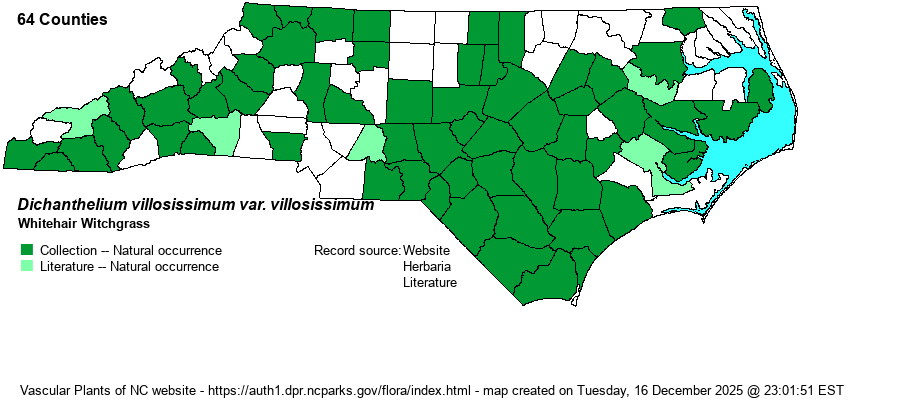| Author | (Nash) Freckmann | |
| Distribution | Essentially throughout the state.
MA to MI and KS, south to FL and TX; Mex., C.A. | |
| Abundance | Frequent to common. | |
| Habitat | Dry sandy soil of pine-oak and oak-hickory woodlands, openings, trailsides, powerlines, roadsides, fields, prairie-like mafic areas. | |
| Phenology | Flowering and fruiting April-September. | |
| Identification | As its name implies, this is among the hairiest of witchgrasses--leaves, sheaths, stems, and spikelets. Compare carefully with D. ovale. | |
| Taxonomic Comments | In FNA treated as D. ovale ssp. villosissimum. A second variety, praecocius, is midwestern. A third variety, pseudopubescens, is lumped within var. villosissimum by Weakley (2018).
A note about Dichanthelium: This genus is not impossible to identify to species! But it takes applied effort over a period of time in order to learn the various species and what their morphological limits are. We strongly recommend that you read the introduction to the treatment in Weakley et al. (2023), written by Richard LeBlond. LeBlond has made order out of near chaos, and his keys work very well for our plants. Most Dichanthelium taxa ("Dichs") do not grow everywhere indiscrimminately, but prefer certain well-defined habitats. Note that most species produce flowers/fruits twice a year -- a vernal period and an autumnal period -- and that measurements of spikelets and achenes are taken from vernal plants. Some species also have a third, or summer, period. In the vernal period there is a single inflorescence at the tip of the stem. In the autumnal period, plants produce elongate branches with bunched (congested) leaves and so look quite different from vernal plants. Inflorescences are produced in leaf axils as well as at the tips of branches. NOTE: Older texts had these species essentially all within the very large genus Panicum. "Dich" species are typically named as "Witchgrass" and Panicum species named as "Panicgrass". | |
| Other Common Name(s) | | |
| State Rank | S4 [S5] | |
| Global Rank | G5T5 | |
| State Status | | |
| US Status | | |
| USACE-agcp | | |
| USACE-emp | | |

